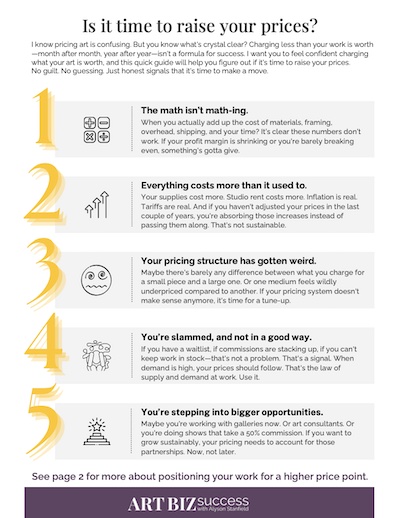As a mature exhibiting artist, you need to create enough work to have a couple of solo exhibits simultaneously. But I know that you want a number.
You’d be happy if I’d say that you’re sitting pretty if you have 20 works in a recognizable style. But I’m not going to do that. (Apologies)

Image (c) Bonnie Hurst, Buffalo Painting #2 (detail)
Some people will tell you to have enough work for two solo exhibits. In her email query to me, Bonnie Hurst noted that Georgia O’Keeffe said three exhibits. Remember back when we used to use slide sheets? We heard that artists needed two pages of slides (40 works) in a recognizable style.
But the answer can’t be the same for every artist. Some artists produce at a much slower rate and the work is grander in scale. They need more room to show it, but fewer pieces to fill the space. Other artists make smaller work. They require less space, but more work to fill it.
Exhibit spaces also vary greatly in size. Unless you’re showing your art at the same place time after time (don’t!), you can’t count on a certain number of pieces.
Bottom line: Use your best judgment. Visit exhibits with artists whose work is similar in size and scale. Count the work if you must.
I think you will know when you’ve hit upon that body of work that defines you. You feel confident in the quality, proud of the results, and ready to share it with the world. Until you feel this way, keep making art.
You can test the waters by entering juried shows here and there, but keep working toward that solo exhibit. You want enough work that when people enter your one-person show or come across it on your website, they know upon sight that the work is yours.




13 thoughts on “How Many Pieces Are in a Body of Work?”
Thank you, Alyson! You have this uncanny ability to answer my unarticulated questions just as they’re forming. How’d you know I was wondering about this this weekend? In league with Santa or something? 😉 Anyway… wonderful post today. Thank you, Laura
Since art fairs and galleries are my milieu, I need to forecast how many paintings will sell at each venue (per year), and have that many plus enough to make the last hanging look like a coherent show. If you’ve never yet hung a group of works together, that is an eye-opener. And, quite a thrill!
Thank you Alyson. I think this has been the best definition of ‘a body of work’ I’ve heard. Painting for 8 years now and it seems I’ve always painted what the theme dictated. Just last week I’ve ventured on a series of bird paintings, just because I can. I truly believe it is defining me. I enjoy reading your words of wisdom weekly. Thank you again. Debbi Green
Would you recommend having separate names for each style that an artist does? Many artists do not stamp out piece after piece of the same stuff and never venture into other styles and techniques….. and even other philosophies. If the public has trouble handling that kind of exploration (which I am assured that it indeed does) should the artist think about choosing a different artist’s name and statement and, perhaps, even a different website for each definable style?
A coherent body of work happens naturally, It takes time- sometimes a long time for an artist to find his or her way there. The best way to hurry the process along is to be honest with oneself about which themes strike the deepest chord in you. You have to go down more than a few dead ends along the way. The worst thing would be to decide ahead of time “this is what I am interested in”, crank out a body of work, have some commercial success with it, and THEN discover you’re bored stiff at the prospect of doing more work in a similar vein. There is a tension between building an authentic creative vision and the demands of marketing it. But this is nothing new- the artists from the past we admire today faced the same challenge. If they managed the juggling, so can we.
Alyson is right (when is she not?). Quality and not quantity is what will determine a gallery’s willingness to hang a solo show. Naturally there would be a certain minimum number of works needed to make it a viable business decision for a gallery to put on a show. Karen’s comment reminded of my grandfather’s good friend, Alan Dunn. For over twenty years, Dunn was a very successful cartoonist for New Yorker and known for his sophisticated humor and coarse charcoal drawing style. My grandfather told me about Dunn’s other side. He and Dunn would go on watercolor expeditions. He knew that Dunn deeply wished to also be know for his watercolor paintings. His watercolor work was exquisite and subtle, having little in common with his cartoon work. The public wasn’t interested in the watercolors. They wanted what they expected from Alan Dunn and nothing else. Maybe using a pseudonym would have worked for him. On the other hand Picasso was able to work in several visual languages a time and find an audience for them all. It is fascinating, and frustrating that there are no hard and fast rules in what makes art appealing to an audience. I hope that learning my craft, doing the best work I know how, and being true to my vision will bring coherence to my body of work. I know I have to make choices in the subject and approach in order to consciously (sometime not so consciously) guide where that body of work is going. I sometimes wish could have a solid vision of what that body of work will look like in the future. But I don’t. That is part of adventure. And whether the market will be embrace or reject the work – well, I will do everything that I know how to let the world know my work is out there. The rest is in God’s hands.
Wonderful post (and newsletter), Alyson. This is something I’ve been working on. Doing lots of related themes, but having trouble staying on track after about 9 months of still life. Craving to do some landscapes now that the weather is springtime pleasant. I know my subjects are all over the map, but I’m trying to keep cohesiveness with strong common elements. Thanks for the food for thought!
Creating a body of work. Here’s my strategy and it works fairly well. I’m very much into music, so I started thinking of preparing a show as a rock band or composer would write and album. I’ve also learned to work on several canvases at a time. Some how this keeps the work closely linked together. I’ve also learned to let motifs, color , characters, buildings, and collaged items be shared throughout the works. You’ll notice when listening to some musical albums that drum beats, guitar lyrics and song lyrics may be referenced from a previous track. Each solo show for my work represents a cohesive body of work rather than thematically selected work.
Thank you for taking the time to answer my question! I believe I have a better idea of what I need to do to have a body of work to show. I have also been encouraged by reading the comments from other artists on the same subject.
Laura: Why, yes! Santa and I are tight. Sandra: I’m not sure about separate names for styles. Maybe separate names for different lines. (One more commercial, the other more “serious.”) Philip: Exactly! Work through it. Keep making art. Michael: Quite often I’m wrong. It just took me many years to admit that. Thanks for the story about Dunn. Also, note that Picasso worked through his styles. He never really did the Rose Period alongside Cubism. He worked through the Rose Period to get to Cubism. So we can see his progression. It’s harder when the work is being done simultaneously. Bonnie: Thanks for sharing your question.
I’m really new at this, so this may seem a bit simplistic, but if I’m creating sculptures to supply my galleries and preparing for summer art fairs and preparing for a group/or solo exhibitions, I find myself robbing-Peter-to-pay Paul–and sometimes ‘breaking up’ what might have been a ‘body of work’ for a solo or group exibition, but needing to make sure the galleries have what they need. Any ideas that will help?
So Alyson, do you think an artist needs to have this many available works in the studio at any given time? I’ve done landscapes long enough to have what I feel is a coherent body of work. I don’t have any problem pulling together images to send to galleries etc., but I never have more than maybe 5-6 finished paintings in my studio at a time. They’re always at galleries or in shows, and if I start to have more paintings in my studio than that, I start to think I need to find another gallery or something. So when I have a show, I have to spend a couple of months painting to have enough works… Do you think an artist should have enough work available to put on a show at any given time? Should I be trying to catch up and have a large in-studio inventory?
Pingback: What is a body of work? — Art Biz Blog